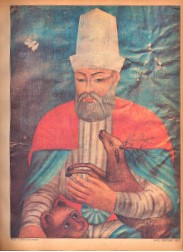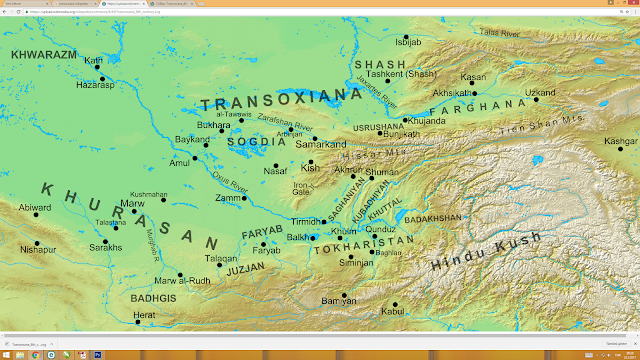CONSIDERS YEARS REGION CITY COUNTRY STATE VOCATION NOTES RESOURCES NOTES
JABIR BIN HAYYAN first 721-815 Khorasan Tus, Iran IRAN Chemistry “Dominate Chemistry, dominate the world”
MERUZÎ ………-869 Khorasan Merv, Turkmenistan Turkmenistan Mathematics First trigonometric ratios, sine, cosine, conant, cotangent https://en.wikipedia.org/wiki/Habash_al-Hasib_al-Marwazi
EBU’L-VEFA ELBUZCANÎ 940 – 998 Khorasan Buzhgan, Iran IranMathematics significantly improved Astronomy Khwarezmi’s discoveries in mathematics and geometry. He especially focused on the relations between geometry and algebra https://en.wikipedia.org/wiki/Ab% C5%AB_al-Waf%C4%81’_B%C5%ABzj%C4%81n%C4%AB
NİZAMÜLMULK 1018-1092 Khorasan Tus, Iran Iran PoliticsnameThe founder of the country’s orders, those who guide us, alatlı http://tr.wikipedia.org/wiki/M%C3%BCslim_bin_Hacc%C3%A2c
SHEIKH YUSUF HEMEDANI 1048-1140 Khorasan Hamadan, Iran, Iran Islam “Teacher of Hodjas”
ÖMER HAYYAM 1048-1131 Khorasan Nishapur , Iran Iran Philosophy, Mathematics, Astronomy Justice is the soul of the universe.
GAZZALI 1058-1111 Khorasan Tus, Iran Iran Islam The body is the land of the heart. There are many soldiers of the heart in this country. those who guide us
NASRUDDIN ET TUSI 1201-1274 Khorasan Tus, Iran Iran The Great Islamic Scholar, Who Created Works for the First Time in the Field of Philosophy, Mathematics, Trigonometry. Those who gave direction to us, the Alati Seljuk period https://en.wikipedia.org/wiki/Nasir_al-Din_al-Tusi Anatolia, Iran and Turkistan jointly Ottoman scientific life with the contributions of scholars in the cultural basin, especially members of the Samarkand mathematics-astronomy school; In addition to linguistic, literary, religious and theological sciences, he rapidly increased his level in the field of philosophy and philosophy. The works that these scholars brought with them were rapidly multiplied and put into circulation through the process of copying. Occupying the most obvious place in this production activity is Nasîrüddîn Tusi’s Tahrîrât. Tahrîrât includes the main hypothetical works written in the Ancient Greek and Islamic world, called Mutevassitât, between Euclid’s Usul and Ptolemy’s Macestî.These works are the main works in the field of hypothetical sciences, which are constantly copied when needed in the Ottoman country. The fact that the facsimile was copied for the opinion of Mehmed the Conqueror, and as a result, the scribes were more careful and produced an authentic text, further increasing the importance of the copy, its ease of reading and its visual richness.
MEVLANA 1207-1273 Khorasan Belh, Afghanistan Afghanistan Sufi Mystic Didn’t we love the Creator without seeing? Mesnevî, which is one of the most important and most beautiful literary and mystical works of classical Eastern literature, consists of 6 volumes called notebooks. It is a work written by Hüsameddin Çelebi, sung in the last fifteen years of Mevlânâ’s life, who migrated from the city of Belh where he was born and resided in Konya, one of the central cities of Anatolia, and voiced the truth to all humanity from there. Mesnevî, which is one of the rare works that has survived until today without losing anything of its value since the 13th century when it was said and written, continues to maintain its influence on large masses all over the world and to be read in various languages today. The number of languages it has been translated into and the commentaries made on it show its scope and level of fame.Even today, Mesnevî, who carries the secret of the purpose of creation, resonates in every heart, and moves the minds with the ability to think on the summits of contemplation; One of the oldest manuscripts, which was copied 100 years after the death of Mevlana, Süleymaniye Manuscript Library, Halet Efendi, with the facsimile of the copy registered at 171. Dr. Derya Ors – Prof. Dr. It has been translated and prepared for publication by Hicabi Kırşığı.It has been translated and prepared for publication by Hicabi Kırşığı.It has been translated and prepared for publication by Hicabi Kırşığı.
HACI BEKTAŞ VELİ 1209-1271 Khorasan Nishapur, Iran Iranian Sufi”The Saints of Khorasan”

Sheikh Küster ……..-1400 Khorasan Küster, Iran Iranian Sufi Old Karagöz masters call him “Our Pir Sheikh Küster”
Abul Hasan al Amiri d.992 Khorasan Nishapur IRAN
Kutbuddin Razi 1293-1365 Khorasan Rey, Veramin IRAN
Abdul’ali Bircendi D 1525-26 Khorasan Bircend, Khorasan Iranian Mathematician, astronomer, jurist. http://www.ihsanfazlioglu.net/yayinlar/makaleler/1.php?id=112
Nesevî He. After 1100, Khorasan Nesa Turkmenistan Mathematician and astronomer. From the information obtained from him at the end of a copy of Nesevî’s et-Tecrîd, dated 551 (1156) or 557 (1162), it is learned that Avicenna came to his house and wrote a part of al-Ķānûn fi’ŧ-ŧıbb there. Bîrûnî was one of the famous people who visited this house, which was a large library and a place of science; Nesevî describes him as short and “the scholar with the most sound knowledge” (mutkin). According to the information he gave himself, Nesevî was in Rey and Isfahan during the reign of Buwayhi Ruler Mecdüddevle (997-1029). Upon the capture of Rey by Mahmud of Gazne in 1029, Sultan Mahmud and II. He lived in Ghazni for a long time during the Masud era. After the collapse of the Ghaznavids, he entered the service of the Seljuk rulers in Isfahan,especially found near Tuğrul Bey. Nesevî wrote Bâzname in 472 (1079) and after this date and Ali b. Based on the fact that Zayd al-Bayhakī states that he lived more than 100 years, it can be said that he died in 493 (1100) at the earliest. Nesevî is one of the leading mathematicians in the history of mathematics who knows the decimal concept based on Hisâb-i Hindi. First of all, he applies hisâb-i Hindi techniques to the unit fraction understanding of hisâb-i zihnî. On the other hand, he constructs hisâb-i sittîn according to Indian numbers and applies it to basic arithmetic operations made with this base. http://www.ihsanfazlioglu.net/yayinlar/makaleler/1.php?id=104In the history of mathematics, he is one of the leading mathematicians who know the decimal concept based on Hisâb-i Hindi. First of all, he applies hisâb-i Hindi techniques to the unit fraction understanding of hisâb-i zihnî. On the other hand, he constructs hisâb-i sittîn according to Indian numbers and applies it to basic arithmetic operations made with this base. http://www.ihsanfazlioglu.net/yayinlar/makaleler/1.php?id=104In the history of mathematics, he is one of the leading mathematicians who know the decimal concept based on Hisâb-i Hindi. First of all, he applies hisâb-i Hindi techniques to the unit fraction understanding of hisâb-i zihnî. On the other hand, he constructs hisâb-i sittîn according to Indian numbers and applies it to basic arithmetic operations made with this base. http://www.ihsanfazlioglu.net/yayinlar/makaleler/1.php?id=104





















